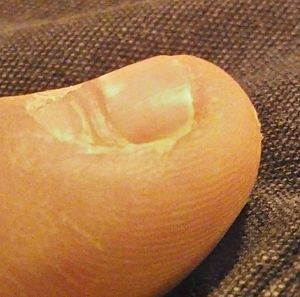Beau's lines
| Beau's lines | |
|---|---|
 |
|
| Beau's lines | |
| Classification and external resources | |
| Specialty | dermatology |
| ICD-10 | L60.4 |
| ICD-9-CM | 703.8 |
| DiseasesDB | 30839 |
Beau's lines are deep grooved lines that run from side to side on the fingernail or the toenail. They may look like indentations or ridges in the nail plate. This condition of the nail was named by a French physician, Joseph Honoré Simon Beau (1806–1865), who first described it in 1846.
Beau's lines are horizontal, going across the nail, and should not be confused with vertical ridges going from the bottom (cuticle) of the nail out to the fingertip. These vertical lines are usually a natural consequence of aging and are harmless. Beau's lines should also be distinguished from Muehrcke's lines of the fingernails. While Beau's lines are actual ridges and indentations in the nail plate, Muehrcke lines are areas of hypopigmentation without palpable ridges; they affect the underlying nail bed, and not the nail itself. Beau's lines should also be distinguished from Mees' lines of the fingernails, which are areas of discoloration in the nail plate.
There are several causes of Beau's lines. It is believed that there is a temporary cessation of cell division in the nail matrix. This may be caused by an infection or problem in the nail fold, where the nail begins to form, or it may be caused by an injury to that area. Some other reasons for these lines include trauma, coronary occlusion, hypocalcaemia, and skin disease. They may be a sign of systemic disease, or may also be caused by an illness of the body, as well as drugs used in chemotherapy or malnutrition. Beau's lines can also be seen one to two months after the onset of fever in children with Kawasaki disease.
Human nails grow at a rate which varies with many factors: age, and the finger or toe in question as well as nutrition. However, typically in healthy populations fingernails grow at about 0.1mm/day and toenails at about 0.05mm/day. With this in mind the date of the stress causing Beau's lines and other identifiable marks on nails can be estimated. As the nail grows out, the ridge visibly moves upwards toward the nail edge. When the ridge reaches the nail edge, the fingertips can become quite sore due to the mis-shapen nail pressing into the flesh deeper than usual, exposing the sensitive nail bed (the quick) at the nail edge.
...
Wikipedia
